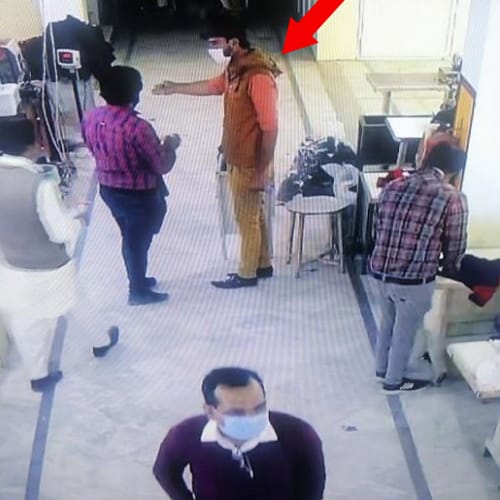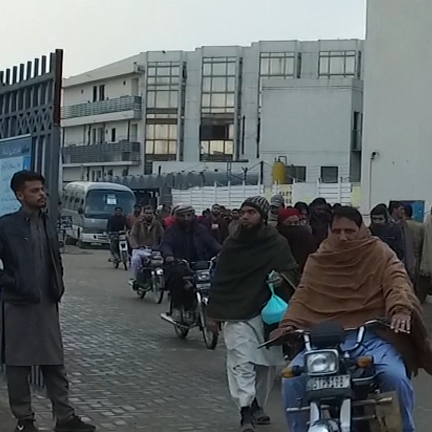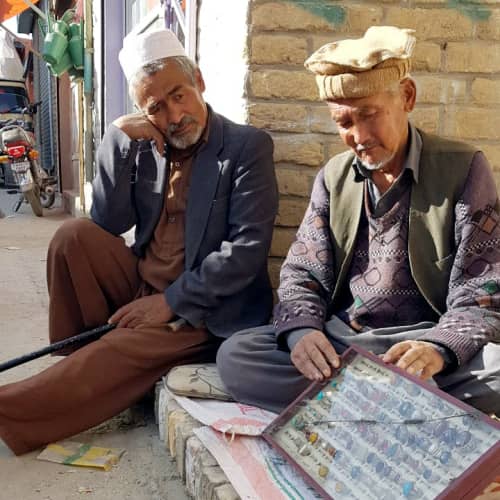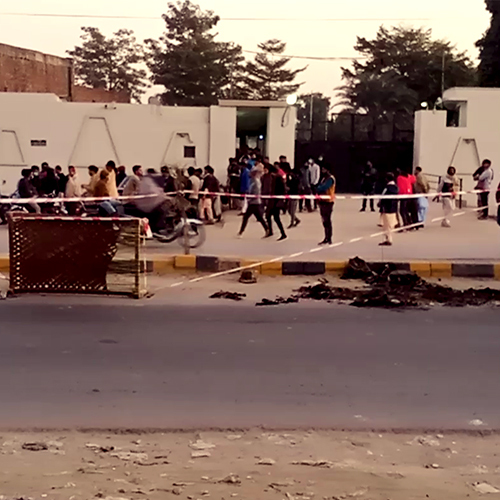Abdul Saboor Butt started working at the Rajco Industries factory on Sialkot-Wazirabad Road on December 1, 2021. The company makes apparel for foreign brands.
Two days later, a mob of labourers lynched Priyantha Kumara, the Sri Lankan general manager at the factory, setting fire to his corpse outside the factory. On December 6, the District Police Officer at Sialkot, Umar Saeed Malik, told reporters that Abdul Saboor Butt worked in the same section of the factory from where the slain manager removed a religious sticker. In a CCTV grab of the moments before his death, the manager could be seen with Abdul Saboor Butt in the same section.
DPO Sialkot said it was Abdul Saboor Butt who assembled the mob that lynched Priyantha Kumara.
Other workers at the factory said it was he who phoned a local leader of the Tehrik Labbiak Pakistan (TLP), telling him about the removal of a sticker with religious inscriptions, asking him to come to the factory.
However, villagers at Lodharay - a village located about four kilometres northeast of Rajco Industries that Butt belongs to - refused to believe reports of his role in lynching of the Sri Lankan national. Nisar Ahmed Butt, a local, said that Abdul Saboor Butt was just a factory worker with no linkages with any political or religious organisation.
Saboor's father had been dead a long time and he and his five brothers had been working as industrial labour for the past many years. Years ago, said villagers at Lodharay, Abdul Saboor Butt had worked with the Rajco Industries and nothing about his conduct that may make him suspect ever came to their notice, nor was he ever involved in anything undesirable.
However, said Nisar, Abdul Saboor Butt was going through a rough patch in life due to some personal issues. He said that Butt had married a woman against the wishes of her parents about five years ago. The couple separated after the birth of a baby girl, and the separation caused him great emotional turmoil.
 Abdul Saboor Butt (in light red shirt) and Priyantha Kumara
Abdul Saboor Butt (in light red shirt) and Priyantha KumaraThe local police presented Butt before the Gujranwala Anti-Terrorism Court on December 6, along with 27 other accused of involvement in the lynching. Police, while declaring the 27 persons as prime suspects in the lynching of Priyantha Kumara, asked for their physical custody in order to complete its investigations.
Among those accused of lynching were Hasnain Ali and Ahmed Shahzad, residents of a Balu Chak village of Sialkot. Balu Chak is located close to Sambrial interchange on Lahore-Sialkot Motorway, about 10 kilometres west of Rajco Industries. Nearly 480 families live in this village and male members of many of these work for Rajco and other nearby factories.
At least 20 people from this village work in the Rajco Industries. They commute to the factory on a daily basis in the company's transport. On the evening of December 7, when the labourers arrived at the village in the evening, none of them agreed to talk about the lynching of Priyantha Kumara.
At first, locals sitting at the barber shop opposite to the bus stop refused to answer any questions. However, when they were sure that the person asking the questions was not a policeman, they started talking about Hasnain Ali and Ahmed Shahzad, the two villagers accused in the lynching case, in cautious tones.
One of the villagers, a 40-something man, said in an emphatic tone that both of the accused were innocent and could do no wrong. This was followed by silence in the shop and those sitting in the shop exchanged glances in a manner as if to admonish the speaker, telling him not to utter another word on the subject.
 A wave of fear has spread among the factory workers after the Sialkot incident
A wave of fear has spread among the factory workers after the Sialkot incidentIn a loud voice, one of the villagers said the village councillor Waheed Murad Cheema would do the rest of the talking on the subject.
The villagers introduced a middle-aged man of about 60 years as Shabbir Hussain, paternal uncle of Hasnain Ali. After much insistence, he reluctantly started talking about his nephew.
He said the youth Hasnain Ali was about 15 year old. When arrested in the lynching case, Ali had claimed that he was 16 years old before the Gujranwala magistrate.
He said that his nephew started working at the Rajco Industries only 20 days ago before the lynching incident.
“Hasnain Ali is very young; he cannot differentiate between good and bad,” Shabbir Hussain said, adding that the detention of his nephew was the result of a misunderstanding or someone has tricked him into committing violence.
In the course of conversation, the village's young councillor Waheed Murad also walked into the barber’s shop and declared that both Hasnain Ali and Ahmed Shahzad lacked the nerve to commit such a heinous crime.
He said that Hasnain Ali and his elder brother were poor labourers working in factories to earn a livelihood.
He said that the boys’ father was dead while mother was a physically challenged lady dependent on her sons.
Defending Shahzad as someone not capable of voilence, he said that village youngsters used to unsavoury epithets to tease him, calling him zanana, a label to suggesting that he was effeminate.
He said that about a decade ago, Shahzad’s father had borrowed Rs 1 million to send his other son to Spain. The boy never bothered to support his family and now his elderly father was working as a labourer to make ends meet.
The councillor said that Ahmed Shahzad had just started to help his father. "Now it seems that the boy would never be able to extricate himself from this case," he said.
Also Read

Hazara Shias of Afghanistan: ‘Taliban are killing us because of our faith and ethnicity’
The story of Raheel Amjad alias Chota Butt is similar to that of Ahmad Shahzad. He is a resident of Chak Chaudho, located about five kilometres north of Chak Balu, and like Shahzad, one of the prime suspects in the lynching of Priyantha Kumara.
While some of the villagers consider him an upright person, others said he was mentally unstable.
Raheel’s father, a rickshaw driver, went into hiding along with wife, soon after his son’s arrest. However, the family has since returned to the village on December 9. They do not wish to talk about the lynching incident anymore.
Reality as spectacle
Some four days after the lynching of Priyantha Kumara, when labourers would appear scared of leaving the factory after the day shift.
Right in front of the factory gate, a small pile of ashes still lie, cordoned off from the road with a tape attached to a string bed on one side and a wooden bench on the other. To anyone looking, it is clear that this is the place where Priyantha Kumara’s corpse was set on fire. As labourers pour out of the gate, they try to keep their eyes averted, not looking at the spot.
Opposite to this spot, the owner of a tea-stall is busy making tea while keeping his gaze down. He speaks about the lynching in a manner as if he never witnessed the lynching even though he was there on the day it happened.
In a tone both hushed and sorrowful, he said he was not aware of what happened inside the factory on December 3. "When the mob brought the manager's corpse out of the factory, there were so many people on the road that I could not see anything," he said.
On hearing this conversation, labourers sitting on string beds outside the tea-stall started leaving one by one, as if they did not wish to talk or hear about the lynching incident.
Some of them claimed that they were not there on December 3, having a day off from the job. Others said they did not leave their work stations on that day despite the mayhem accompanying the lynching.
Requesting anonymity, a Rajco Industries' employee finally agreed to narrate the events on that fateful day. He said that one of the factory’s supervisors came to his section and asked labourers to come out while chanting slogans. He said at that point, no one in the section had any idea of what was happening outside. However, once many of the labourers gathered in the factory's yard, the chants turned to religious slogans.
"After that, I stayed in at my station so I don't know what transpired afterwards," he said.
When asked why nobody agreed to have witnessed the lynching, Syed Adul Waheed Bukhari, a prominent lawyer at Sialkot, said that it was the biggest moral dilemma of the society that nobody faced up to facts even in the presence of clear evidence.
Bukhari said that after listening to different narrations and interpretations of Priyantha Kumara’s lynching, it seemed that unknown people were responsible for the murder. “These people seemed to have come from an unknown place and left for there after the murder,” said Bukhari who has served as the counsel for the Rajco Industries in the past, besides holding the position of general secretary at the Sialkot Bar Association and Additional Advocate General, Punjab.
"The habit of lying to save one’s skin has become ingrained among people, notwithstanding, the damage it was causing to others," he said.
Bukhari said that this kind of moral degeneration was reflective of a society whose members committed every wrong in a hyper emotional state and afterwards used all kinds of tricks and excuses to claim innocence.
People living in the vicinity of Rajco Industries said that initially the government was taking stern action due to the fact that the victim was a foreigner. They pointed out that once the matter reached the court, there would be no evidence available against most of the accused. For its part, police had arrested more than 85 people in connection with the lynching. However, the locals said only a few would be punished by the court and even they would be acquitted by higher courts or their sentences would be reduced.
They cited the example of the lynching of brothers Mughees and Muneeb Butt that took place in Sialkot in 2010. According to eyewitness accounts, the lynching was witnessed by a crowd of people including police officials who apparently offered no intervention. The people stood there as the two innocent boys were assaulted by a crowd of people. The police arrested 50 people for the crime but the court sentenced only seven of them to death, while six others faced life imprisonment. The Supreme Court of Pakistan on hearing the appeals of the accused changed the sentences of all accused to 10 years of imprisonment.
Published on 21 Aug 2022




















